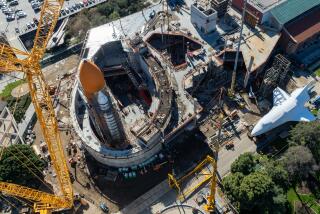New mission for a Mars rover
- Share via
Four years into its mission to explore the surface of Mars, one of NASA’s twin rovers, Opportunity, is about to set out on a do-or-die trek to a giant crater about seven miles away.
Originally expected to survive a few months on the harsh surface of the Red Planet, Opportunity and its twin, Spirit, are still chalking up discoveries, even though both have suffered from wear and tear. Spirit has a gimpy wheel, and a balky shoulder motor on Opportunity requires it to roll along with its robotic arm extended in a constant salute.
To reach the new crater, called Endeavour, Opportunity must drive about seven miles south from Victoria crater, where it has spent the last two years exploring. Seven miles may not seem like a long way, but it would match the total mileage Opportunity has driven since landing on Mars in January 2004.
“We may not get there, but it is scientifically the right direction to go anyway,” said Steve Squyres of Cornell University, the chief scientist for the science instruments on the rovers.
As “we move southward, we expect to be getting to younger and younger layers of rock on the surface,” he said.
On its best days, Opportunity has traveled 200 yards. The science team doesn’t think the dusty, pock-marked rover will be able to do much better than half that pace in its current condition. It is expected to take two years to reach Endeavour crater.
“This is a bolder, more aggressive objective than we have had before,” said John Callas, manager of the rover project at the Jet Propulsion Laboratory in La Canada Flintridge, where the rovers were built.
If it does reach the big crater, Opportunity will provide scientists with a look inside a bowl nearly 14 miles across.
Because Endeavour is deeper than Victoria, looking inside will provide greater clues to the planet’s ancient history, when rivers and even shallow seas may have covered large portions of the landscape. Its previous longest drive was a four-mile trek to Victoria in 2005.
Spirit, meanwhile, will be staying near its current location, a feature known as Home Plate.
Though Opportunity’s trip to the new crater is hazardous, scientists say two recent developments in Mars research will reduce the danger. One was the arrival in 2006 of the Mars Reconnaissance Orbiter, which has a high-resolution camera that will allow rover drivers to pick out the best routes to the crater.
Another new feature is hazard avoidance software that was uploaded to the rover in 2006.
“This is a great example of how different parts of NASA’s Mars Exploration Program reinforce each other,” Callas said.
Equipped with a drilling tool to shave off pieces of rock, the two rovers have found plenty of evidence of ancient water. What happened to it is still a matter of debate.
Meanwhile, scientists managing the Phoenix mission at Mars’ north pole are scrambling to get all the data they can before winter closes in and shrouds the lander in a fatal coating of carbon dioxide ice.
Phoenix has uncovered water ice below ground but has so far not found the organic compounds it was seeking when it landed May 25.
Evidence of complicated organic compounds could indicate the planet was once habitable, or might still be, possibly by underground microorganisms.
--
More to Read
Sign up for Essential California
The most important California stories and recommendations in your inbox every morning.
You may occasionally receive promotional content from the Los Angeles Times.













